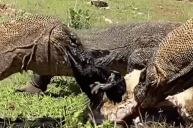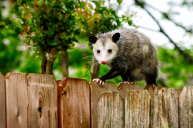It might sound cliche to compare giant lizards to dinosaurs, but new research on the Komodo dragon may provide clues to how long-extinct reptilian carnivores like the Tyrannosaurus rex killed and ate their prey. Researchers from King's College London say they discovered that the serrated edges of Komodo dragons' teeth are tipped with iron.
According to the study published by Nature Ecology & Evolution, the significance of that finding is twofold. First, researchers said that Komodo dragons and carnivorous dinosaurs have teeth that are similar in shape. Second, they think that the iron helps keep their teeth razor sharp.
"Komodo dragons have curved, serrated teeth to rip and tear their prey just like those of meat-eating dinosaurs," said Dr. Aaron LeBlanc, a researcher with the Centre for Oral, Clinical & Translational Sciences and lead author of the study. He added: "We want to use this similarity to learn more about how carnivorous dinosaurs might have ate and if they used iron in their teeth the same way as the Komodo dragon."
Comparing dinosaurs to Komodos

Examining the iron on a Komodo dragon's teeth. Credit: King's College London
Despite the similarities, LeBlanc said there's one hitch. He explained that they used advanced imaging and chemical analysis to find a thin coating of iron on top of the Komodo dragons' tooth serrations and tips. As a result, the animals' teeth appear orange. However, that same technology won't work for dinosaur fossils.
"Unfortunately, using the technology we have at the moment, we can't see whether fossilized dinosaur teeth had high levels of iron or not," LeBlanc said. "We think that the chemical changes which take place during the fossilization process obscure how much iron was present to start with."
Still, LeBlanc explained that "larger meat-eating dinosaurs, like tyrannosaurs, did change the structure of the enamel itself on the cutting edges of their teeth." What that means is that "some dinosaurs altered the structure of their dental enamel to maintain a sharp cutting edge."
LeBlanc explained he thinks with further research they could identify other markers in the iron coating that don't change during fossilization. "With markers like that we would know with certainty whether dinosaurs also had iron-coated teeth and have a greater understanding of these ferocious predators," he said.
Komodo dragons today

A Komodo dragon's teeth have serrated edges. Credit: Smithsonian
Experts like Dr. Benjamin Tapley, the curator of reptiles and amphibians at the London Zoo and co-author of the study, describe Komodos as "inarguably impressive animals." If you've never seen one, they can grow to almost 10 feet long and weigh more than 300 pounds. Plus, they eat just about anything they can, no matter how much their food screams or rots.
"Having worked with them for 12 years at London Zoo, I continue to be fascinated by them and these findings further emphasize just how incredible they are," Tapley said. Given their endangered status, he added that their new research not only helps them understand more about dinosaurs but also about Komodos.
The Smithsonian's National Zoo lists Komodos as "vulnerable" as only a few thousand remain. Although man-made and climate issues contributed to the destruction of their population, they're also native to only a handful of islands in Indonesia.




